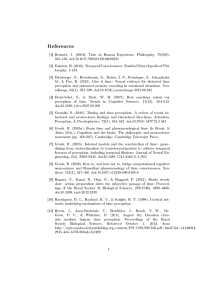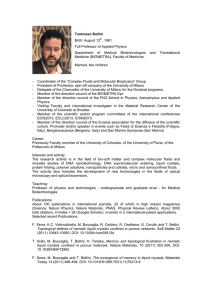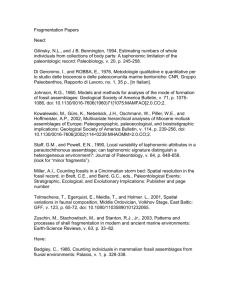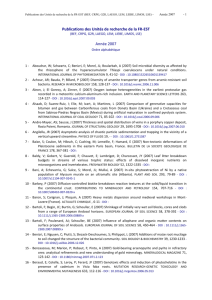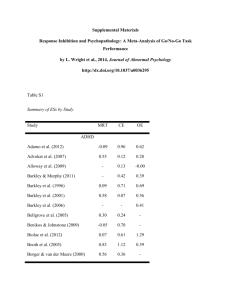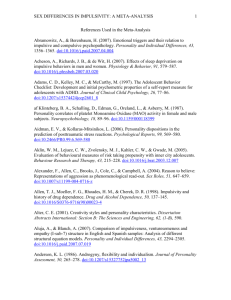AMP.Kosslyn2065.suppmat
advertisement
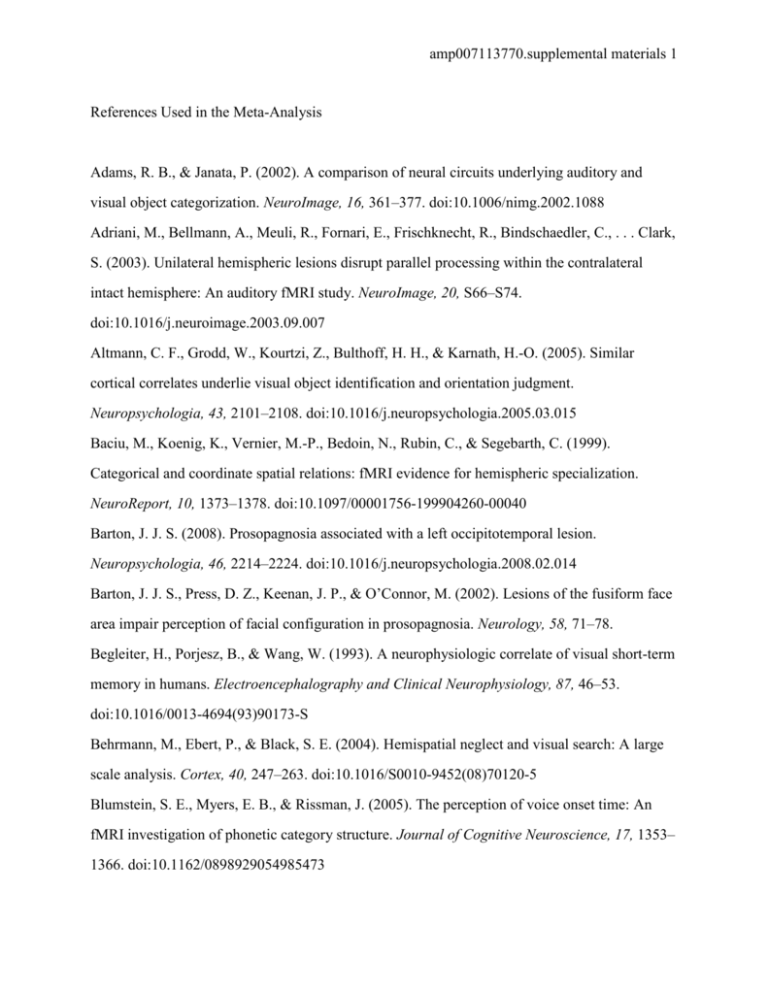
amp007113770.supplemental materials 1 References Used in the Meta-Analysis Adams, R. B., & Janata, P. (2002). A comparison of neural circuits underlying auditory and visual object categorization. NeuroImage, 16, 361–377. doi:10.1006/nimg.2002.1088 Adriani, M., Bellmann, A., Meuli, R., Fornari, E., Frischknecht, R., Bindschaedler, C., . . . Clark, S. (2003). Unilateral hemispheric lesions disrupt parallel processing within the contralateral intact hemisphere: An auditory fMRI study. NeuroImage, 20, S66–S74. doi:10.1016/j.neuroimage.2003.09.007 Altmann, C. F., Grodd, W., Kourtzi, Z., Bulthoff, H. H., & Karnath, H.-O. (2005). Similar cortical correlates underlie visual object identification and orientation judgment. Neuropsychologia, 43, 2101–2108. doi:10.1016/j.neuropsychologia.2005.03.015 Baciu, M., Koenig, K., Vernier, M.-P., Bedoin, N., Rubin, C., & Segebarth, C. (1999). Categorical and coordinate spatial relations: fMRI evidence for hemispheric specialization. NeuroReport, 10, 1373–1378. doi:10.1097/00001756-199904260-00040 Barton, J. J. S. (2008). Prosopagnosia associated with a left occipitotemporal lesion. Neuropsychologia, 46, 2214–2224. doi:10.1016/j.neuropsychologia.2008.02.014 Barton, J. J. S., Press, D. Z., Keenan, J. P., & O’Connor, M. (2002). Lesions of the fusiform face area impair perception of facial configuration in prosopagnosia. Neurology, 58, 71–78. Begleiter, H., Porjesz, B., & Wang, W. (1993). A neurophysiologic correlate of visual short-term memory in humans. Electroencephalography and Clinical Neurophysiology, 87, 46–53. doi:10.1016/0013-4694(93)90173-S Behrmann, M., Ebert, P., & Black, S. E. (2004). Hemispatial neglect and visual search: A large scale analysis. Cortex, 40, 247–263. doi:10.1016/S0010-9452(08)70120-5 Blumstein, S. E., Myers, E. B., & Rissman, J. (2005). The perception of voice onset time: An fMRI investigation of phonetic category structure. Journal of Cognitive Neuroscience, 17, 1353– 1366. doi:10.1162/0898929054985473 amp007113770.supplemental materials 2 Bohlhalter, S., Fretz, C., & Weder, B. (2002). Hierarchical versus parallel processing in tactile object recognition: A behavioural-neuroanatomical study of aperceptive tactile agnosia. Brain, 125, 2537–2548. doi:10.1093/brain/awf245 Boucart, M., Meyer, M. E., Pins, D., Humphreys, G. W., Scheiber, C., Gounod, D., & Foucher, J. (2000). Automatic object identification: An fMRI study. NeuroReport, 11, 2379–2383. doi:10.1097/00001756-200008030-00009 Buffalo, E. A., Bellgowan, P S. F., & Martin, A. (2006). Distinct roles for medial temporal lobe structures in memory for objects and their locations. Learning & Memory, 13, 638–643. doi:10.1101/lm.251906 Canessa, N., Borgo, F., Cappa, S. F., Perani, D., Falini, A., Buccino, G., . . . Shallice, T. (2008). The different neural correlates of action and functional knowledge in semantic memory: An fMRI study. Cerebral Cortex, 18, 740–751. doi:10.1093/cercor/bhm110 Caplovitz, G. P., Barroso, D. J., Hsieh, P.-J., & Tse, P. U. (2008). fMRI reveals that non-local processing in ventral retinotopic cortex underlies perceptual grouping by temporal synchrony. Human Brain Mapping, 29, 651–661. doi:10.1002/hbm.20429 Carlson, T. A., Schrater, P., & He, S. (2003). Patterns of activity in the categorical representations of objects. Journal of Cognitive Neuroscience, 15, 704–717. doi:10.1162/jocn.2003.15.5.704 Chen, J. L., Penhune, V. B., & Zatorre, R. J. (2008). Moving on time: Brain network for auditory–motor synchronization is modulated by rhythm complexity and musical training. Journal of Cognitive Neuroscience, 20, 226–239. doi:10.1162/jocn.2008.20018 Clark, M. A., Merians, A. S., Kothari, A., Poizner, H., Macauley, B., Gonzalez Rothi, L. J., & Heilman, K. M. (1994). Spatial planning deficits in limb apraxia. Brain, 117, 1093–1106. doi:10.1093/brain/117.5.1093 Cooper, A. C. G., & Humphreys, G. W. (2000). Coding space within but not between objects: Evidence from Balint’s syndrome. Neuropsychologia, 38, 723–733. doi:10.1016/S00283932(99)00150-5 amp007113770.supplemental materials 3 Corbetta, M., Tansy, A. P., Stanley, C. M., Astafiev, S. V., Snyder, A. Z., & Shulman, G. L. (2005). A functional MRI study of preparatory signals for spatial location and objects. Neuropsychologia, 43, 2041–2056. doi:10.1016/j.neuropsychologia.2005.03.020 Davare, M., Andres, M., Clerget, E., Thonnard, J.-L., & Olivier, E. (2007). Temporal dissociation between hand shaping and grip force scaling in the anterior intraparietal area. The Journal of Neuroscience, 27, 3974 –3980. doi:10.1523/JNEUROSCI.0426-07.2007 Desai, R., Liebenthal, E., Waldron, E., & Binder, J. R. (2008). Left posterior temporal regions are sensitive to auditory categorization. Journal of Cognitive Neuroscience, 20, 1174–1188. doi:10.1162/jocn.2008.20081 Eslinger, P. J., & Grattan, L. M. (1994). Altered serial position learning after frontal lobe lesion. Neuropsychologia, 32, 729–739. doi:10.1016/0028-3932(94)90032-9 Farrell, M. J., & Robertson, I. H. (2000). The automatic updating of egocentric spatial relationships and its impairment due to right posterior cortical lesions. Neuropsychologia, 38, 585–595. doi:10.1016/S0028-3932(99)00123-2 Fridman, E. A., Immisch, I., Hanakawa, T., Bohlhalter, S., Waldvogel, D., Kansaku, K., . . . Hallett, M. (2006). The role of the dorsal stream for gesture production. NeuroImage, 29, 417– 428. doi:10.1016/j.neuroimage.2005.07.026 Gauthier, I., Anderson, A. W., Tarr, M. J., Skudlarski, P., & Gore, J. C. (1997). Levels of categorization in visual recognition studied using functional magnetic resonance imaging. Current Biology, 7, 645–651. doi:10.1016/S0960-9822(06)00291-0 Gentilucci, M., Bertolani, L., Benuzzi, F., Negrotti, A., Pavesi, G., & Gangitano, M. (2000). Impaired control of an action after supplementary motor area lesion: A case study. Neuropsychologia, 38, 1398–1404. doi:10.1016/S0028-3932(00)00044-0 Goel, V., Makale, M., & Grafman, J. (2004). The hippocampal system mediates logical reasoning about familiar spatial environments. Journal of Cognitive Neuroscience, 16, 654–664. doi:10.1162/089892904323057362 amp007113770.supplemental materials 4 Goodale, M. A., Meenan, J. P., Bulthofft, H. H., Nicolle, D. A., Murphy, K., & Racicot, C. (1994). Separate neural pathways for the visual analysis of object shape in perception and prehension. Current Biology, 4, 604–610. doi:10.1016/S0960-9822(00)00132-9 Gréa, H., Pisella, L., Rossetti, Y., Desmurget, M., Tilikete, C., Grafton, S., . . . Vighetto, A. (2002). A lesion of the posterior parietal cortex disrupts on-line adjustments during aiming movements. Neuropsychologia, 40, 2471–2480. doi:10.1016/S0028-3932(02)00009-X Halgren, E., Mendola, J., Chong, C. D. R., & Dale, A. M. (2003). Cortical activation to illusory shapes as measured with magnetoencephalography. NeuroImage, 18, 1001–1009. doi:10.1016/S1053-8119(03)00045-4 Haramati, S., Soroker, N., Dudai, Y., & Levy, D. A. (2008). The posterior parietal cortex in recognition memory: A neuropsychological study. Neuropsychologia, 46, 1756–1766. doi:10.1016/j.neuropsychologia.2007.11.015 Harrington, D. L., Rao, S. M., Haaland, K. Y., Bobholz, J. A., Mayer, A. R., Binder, J. R., & Cox, R. W. (2000). Specialized neural systems underlying representations of sequential movements. Journal of Cognitive Neuroscience, 12, 56–77. doi:10.1162/08989290051137602 Hugdahl, K., Lundervold, A., Ersland, L., Smievoll, A. I., Sundberg, H., Barndon, R., & Roscher, B. E. (1999). Left frontal activation during a semantic categorization task: An fMRIstudy. International Journal of Neuroscience, 99, 49–58. doi:10.3109/00207459908994312 Husain, F. T., Fromm, S. J., Pursley, R. H., Hosey, L. A., Braun, A. R., & Horwitz, B. (2006). Neural bases of categorization of simple speech and nonspeech sounds. Human Brain Mapping, 27, 636–651. doi:10.1002/hbm.20207 Jakobson, L. S., Archibald, Y. M., Carey, D. P., & Goodale, M. A. (1991). A kinematic analysis of reaching and grasping movements in a patient recovering from optic ataxia. Neuropsychologia, 29, 803–809. doi:10.1016/0028-3932(91)90073-H James, T. W., Culham, J., Humphrey, K., Milner, D. A., & Goodale, M. A. (2003). Ventral occipital lesions impair object recognition but not object-directed grasping: An fMRI study. Brain, 126, 2463–2475. doi:10.1093/brain/awg248 amp007113770.supplemental materials 5 Janata, P. (2005). Brain networks that track musical structure. Annals of the New York Academy of Science, 1060, 111–124. doi:10.1196/annals.1360.008 Karatekin, C., Lazareff, J. A., & Asarnow, R. F. (1999). Parallel and serial search in two teenagers with lesions of the mesial parietal cortex. Neuropsychologia, 37, 1461–1468. Kosslyn, S. M., Daly, P. F., McPeek, R. M., Alpert, N. M., Kennedy, D. N., & Caviness, V. S. (1993). Using locations to store shape: An indirect effect of a lesion. Cerebral Cortex, 3, 567– 582. doi:10.1093/cercor/3.6.567 Larsson, J., Amunts, K., Gulyás, B., Malikovic, A., Zilles, K., & Roland, P. E. (2002). Perceptual segregation of overlapping shapes activates posterior extrastriate visual cortex in man. Experimental Brain Research, 143, 1–10. doi:10.1007/s00221-001-0895-6 Liu, X., Steinmetz, N. A., Farley, A. B., Smith, C. D., & Joseph, J. E. (2008). Mid-fusiform activation during object discrimination reflects the process of differentiating structural descriptions. Journal of Cognitive Neuroscience, 20, 1711–1726. doi:10.1162/jocn.2008.20116 McDermott, K. B., Petersen, S. E., Watson, J. M., & Ojemann, J. G. (2003). A procedure for identifying regions preferentially activated by attention to semantic and phonological relations using functional magnetic resonance imaging. Neuropsychologia, 41, 293–303. doi:10.1016/S0028-3932(02)00162-8 Morgan, H. M., Jackson, M. C., Klein, C., Mohr, H., Shapiro, K. L., & Linden, D. E. J. (2010). Neural signatures of stimulus features in visual working memory: A spatiotemporal approach. Cerebral Cortex, 20, 187–197. doi:10.1093/cercor/bhp094 Nobre, A. C., Allison, T., & McCarthy, G. (1994). Word recognition in the human inferior temporal lobe. Nature, 372, 260–263. doi:10.1038/372260a0 Ogawa, K., & Inui, T. (2009). The role of the posterior parietal cortex in drawing by copying. Neuropsychologia, 47, 1013–1022. doi:10.1016/j.neuropsychologia.2008.10.022 Owen, A. M., Downes, J. J., Sahakian, B. J., Polkey, C. E., & Robbins, T. W. (1990). Planning and spatial working memory following frontal lobe lesions in man. Neuropsychologia, 28, 1021– 1034. doi:10.1016/0028-3932(90)90137-D amp007113770.supplemental materials 6 Pisella, L., Berberovic, N., & Mattingley, J. B. (2004). Impaired working memory for location but not for colour or shape in visual neglect: A comparison of parietal and nonparietal lesions. Cortex, 40, 379–390. doi:10.1016/S0010-9452(08)70132-1 Poizner, H., Mack, L., Verfaellie, M., Gonzalez Rothi, L. J., & Heilman, K. M. (1990). Threedimensional computergraphic analysis of apraxia neural representations of learned movement. Brain, 113, 85–101. doi:10.1093/brain/113.1.85 Rao, H., Zhou, T., Zhuo, Y., Fan, S., & Chen, L. (2003). Spatiotemporal activation of the two visual pathways in form discrimination and spatial location: A brain mapping study. Human Brain Mapping, 18, 79–89. doi:10.1002/hbm.10076 Rumiati, R. I., Weiss, P. H., Shallice, T., Ottoboni, G., Noth, J., Zilles, K., & Fink, G. R. (2004). Neural basis of pantomiming the use of visually presented objects. NeuroImage, 21, 1224– 1231. doi:10.1016/j.neuroimage.2003.11.017 Sass, K., Sachs, O., Krach, S., & Kircher, T. (2009). Taxonomic and thematic categories: Neural correlates of categorization in an auditory-to-visual priming task using fMRI. Brain Research, 1270, 78–87. doi:10.1016/j.brainres.2009.03.013 Schendan, H. E., & Stern, C. E. (2007). Mental rotation and object categorization share a common network of prefrontal and dorsal and ventral regions of posterior cortex. NeuroImage, 35, 1264–1277. doi:10.1016/j.neuroimage.2007.01.012 Schubotz, R. I., Sakreida, K., Tittgemeyer, M., & von Cramon, D. Y. (2004). Motor areas beyond motor performance: Deficits in serial prediction following ventrolateral premotor lesions. Neuropsychology, 18, 638–645. doi:10.1037/0894-4105.18.4.638 Schubotz, R. I., & von Cramon, D. Y. (2001). Interval and ordinal properties of sequences are associated with distinct premotor areas. Cerebral Cortex, 11, 210–222. doi:10.1093/cercor/11.3.210 Sergent, J., Ohta, S., & MacDonald, B. (1992). Functional neuroanatomy of face and object processing: A positron emission tomography study. Brain, 115, 15–36. doi:10.1093/brain/115.1.15 amp007113770.supplemental materials 7 Sergent, J., Zuck, E., Levesque, M., & MacDonald, B. (1992). Positron emission tomography study of letter and object processing: Empirical findings and methodological considerations. Cerebral Cortex, 2, 68–80. doi:10.1093/cercor/2.1.68 Sestieri, C., Di Matteo, R., Ferretti, A., Del Gratta, C., Caulo, M., Tartaro, A., . . . Romani, G. L. (2006). “What” versus “Where” in the audiovisual domain: An fMRI study. NeuroImage, 33, 672–680. doi:10.1016/j.neuroimage.2006.06.045 Sorger, B., Goebel, R., Schiltz, C., & Rossion, B. (2007). Understanding the functional neuroanatomy of acquired prosopagnosia. NeuroImage, 35, 836–852. doi:10.1016/j.neuroimage.2006.09.051 Suzuki, M., Fujii, T., Tsukiura, T., Okuda, J., Umetsu, A., Nagasaka, T., . . . Yamadori, A. (2002). Neural basis of temporal context memory: A functional MRI study. NeuroImage, 17, 1790–1796. doi:10.1006/nimg.2002.1303 Van der Linden, M., Murre, J. M. J., & van Turennout, M. (2008). Birds of a feather flock together: Experience-driven formation of visual object categories in human ventral temporal cortex. PLoS One, 3, e3995. doi:10.1371/journal.pone.0003995 Wang, J., Zhou, T., Qiu, M., Du, A., Cai, K., Wang, Z., . . . Chen, L. (1999). Relationship between ventral stream for object vision and dorsal stream for spatial vision: An fMRI and ERP study. Human Brain Mapping, 8, 170–181. doi:10.1002/(SICI)1097-0193(1999)8:4<170::AIDHBM2>3.0.CO;2-W Weiss, P. H., Rahbari, N. N., Lux, S., Pietrzyk, U., Noth, J., & Fink, G. R. (2006). Processing the spatial configuration of complex actions involves right posterior parietal cortex: An fMRI study with clinical implications. Human Brain Mapping, 27, 1004–1014. doi:10.1002/hbm.20239 Wu, D. H., Waller, S., & Chatterjee, A. (2007). The functional neuroanatomy of thematic role and locative relational knowledge. Journal of Cognitive Neuroscience, 19, 1542–1555. doi:10.1162/jocn.2007.19.9.1542 Xu, Y. (2008). Representing connected and disconnected shapes in human inferior intraparietal sulcus. NeuroImage, 40, 1849–1856. doi:10.1016/j.neuroimage.2008.02.014 amp007113770.supplemental materials 8 Xu, Y., & Chun, M. M. (2007). Visual grouping in human parietal cortex. Proceedings of the National Academy of Sciences of the United States of America, 104, 18766–18771. doi:10.1073/pnas.0705618104 Zalla, T., Pradat-Diehl, P., & Sirigu, A. (2003). Perception of action boundaries in patients with frontal lobe damage. Neuropsychologia, 41, 1619–1627. doi:10.1016/S0028-3932(03)00098-8
